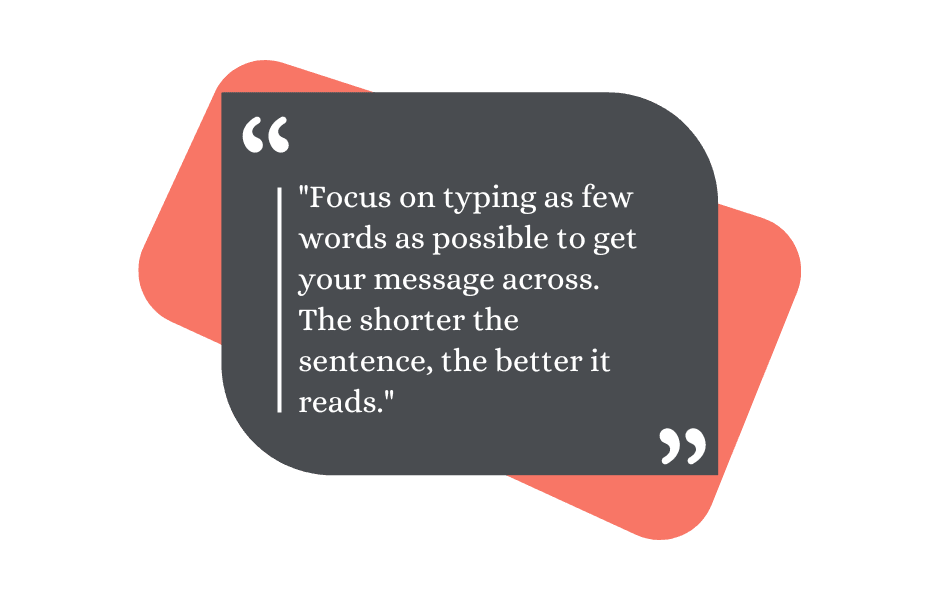A brief guide to writing well to communicate better
Copywriting

Writing is difficult. It’s so much easier to pick up the phone and call someone, or speak to them face to face.
In 2020, in-person conversation is in short supply, especially at a professional level when many of us are working from different locations. Phones aside, much of our daily correspondence is written. We take to email, messaging platforms, Slack and so on, to communicate with our workmates. Yet not everyone is good at writing, so I’ve put together a few short tips to help you improve your writing to communicate better.
Avoid stuffy sentences
Important people love to formalise everything, from the clothes they wear to the office, to the words they use when they write a memo or email. And there’s a solid business case for this approach. However, most of the time we don’t need to be so formal, particularly when it’s in-house communication. Instead, keep things simple and informal. Let’s replace …
There is an argument for your line of thought to be explored further.
with …
Love your idea! Let’s talk about it soon!
We could dive into the psychology of why we formalise things, but let’s not. This article is about writing! The best way to practice avoiding formal thinking is to check yourself before you start typing. This is similar to checking yourself before you speak, which may get rid of that annoying “like” thing many people do. If they took the time to pause before speaking, they could formulate a better sentence in their head and avoid using the “like” filler. The same applies to your writing.

We’re capable of sounding incredibly pompous through writing, because we often use big words to make ourselves sound professional/educated/authoritative. I love learning new words, and there’s a time and place to unleash them in your writing, but probably not to your work colleagues. Use the “like” test and pause before you type. Focus on typing as few words as possible to get your message across. The shorter the sentence, the better it reads. However, be sure that the meaning behind your sentence is straightforward and that it doesn’t confuse people.
Avoid business speak and jargon
As a copywriter, it’s my business to improve a company’s corporate messages. One of the ways I do this is to remove as much jargon as possible. People often ask me to edit a white paper or blog before it’s published, and this is when I get my writer’s toolkit out. As a writing nerd, I get my kicks from rewriting sentences that don’t make sense, or chopping unnecessary words out of perfectly reasonable paragraphs. If I can shorten a piece of writing and still get across its core message, I consider it a job well done.
Here’s where you get to practice your pause again, only this time it’s at the end of your email. Before you enthusiastically hit that send button, check yourself and go over what you’ve written. Does it make sense? Does it create more questions than it answers? Is it full of unnecessary words where simpler ones would have done? Did you assume knowledge on behalf of the person you’re writing to? Here’s an email that ticks all the wrong boxes for me:
Dear Marketing Team,
We are approaching Q3 and in order to exceed expectations and meet BOFU targets, please put together a presentation for Monday coming and include assessments based on 1HY analytics.
Thanks in advance.
That’s so stuffy! Yet, we’re all capable of writing emails like this. Let’s pause and consider what the message actually is. It’s a request to create a presentation to help the company understand what changes to make to improve sales targets. Let’s try again …
Hey Dave and Sara! Next Monday’s sales meeting needs you! We’re short of good 2020 data. Can you help?
Did you notice the significant change of tone? We can do so much more with our writing when we pause, read it again and rewrite.
Check your slang at the door
I’m guilty of this one. I use slang phrases or idioms such as “Bob’s your uncle” and “it sounds like codswallop” when other words would have done! My intention is never to confuse, but to add humour or diffuse a heated email thread, or to liven up a dull Slack feed. Again, there’s a time and a place to use slang and idioms, and if you know your colleagues well, go for it. On the other hand, if you regularly communicate with remote workmates in different regions or countries, they may not understand what you’re saying and may not think you’re funny at all.
Do we need examples for this? Probably not. You know when you’ve said quid instead of pound, or knackered instead of tired. Think of your pause moment again and consider your use of language before the message goes out. Think of your eventual audience, not just the people you’re directly messaging. When your email goes out, it may be seen by many more people than you initially expected, so be sure it’s clean, understandable and not ambiguous.
Three tips to improve your writing
So, avoid self-important language, avoid jargon and avoid slang. These are three simple tips to get you started on improving your writing skills when you’re communicating with workmates, wherever they are in the world. It’s not quite the full Monty, but it’s as mint as I can get it this morning.



